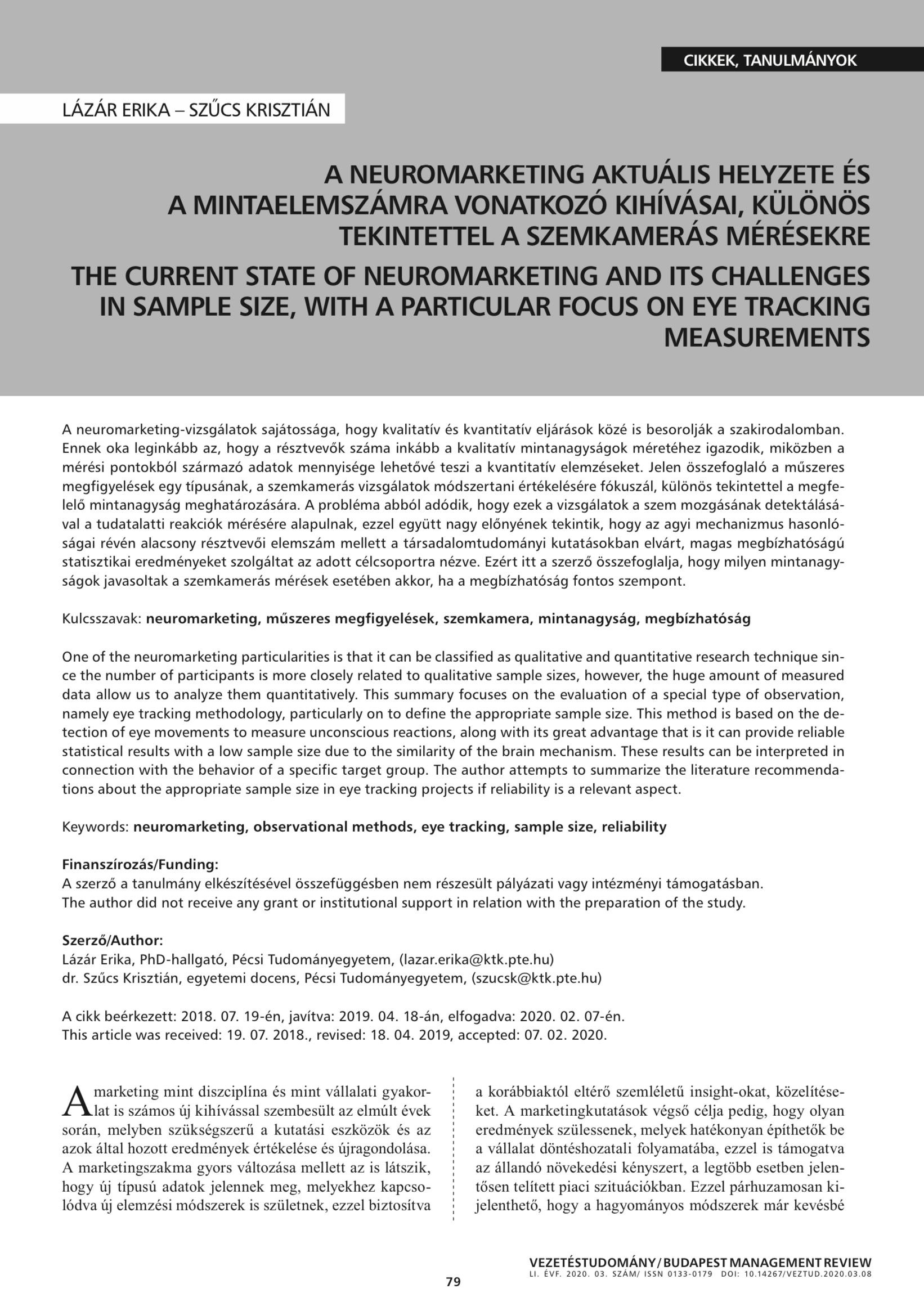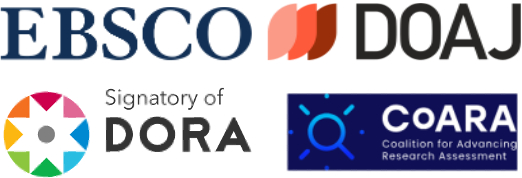A neuromarketing aktuális helyzete és a mintaelemszámra vonatkozó kihívásai, különös tekintettel a szemkamerás mérésekre
DOI:
https://doi.org/10.14267/VEZTUD.2020.03.08Kulcsszavak:
neuromarketing, műszeres megfigyelések, szemkamera, mintanagyság, megbízhatóságAbsztrakt
A neuromarketing-vizsgálatok sajátossága, hogy kvalitatív és kvantitatív eljárások közé is besorolják a szakirodalomban. Ennek oka leginkább az, hogy a résztvevők száma inkább a kvalitatív mintanagyságok méretéhez igazodik, miközben a mérési pontokból származó adatok mennyisége lehetővé teszi a kvantitatív elemzéseket. Jelen összefoglaló a műszeres megfigyelések egy típusának, a szemkamerás vizsgálatok módszertani értékelésére fókuszál, különös tekintettel a megfelelő mintanagyság meghatározására. A probléma abból adódik, hogy ezek a vizsgálatok a szem mozgásának detektálásával a tudatalatti reakciók mérésére alapulnak, ezzel együtt nagy előnyének tekintik, hogy az agyi mechanizmus hasonlóságai révén alacsony résztvevői elemszám mellett a társadalomtudományi kutatásokban elvárt, magas megbízhatóságú statisztikai eredményeket szolgáltat az adott célcsoportra nézve. Ezért itt a szerző összefoglalja, hogy milyen mintanagyságok javasoltak a szemkamerás mérések esetében akkor, ha a megbízhatóság fontos szempont.
Letöltések
Hivatkozások
Ariely, D., & Berns, G. (2010). Neuromarketing: the hope and hype of neuroimaging in business. Nature Reviews Neuroscience, 11(4), 284-292. https://doi.org/10.1038/nrn2795
Bacchetti, P. (2013). Small sample size is not the real problem. Nature Reviews Neuroscience, 14(8), 585.https://doi.org/10.1038/nrn3475-c3
Bárczi J., Lőkösi K., & Gál Zs. (2017). A statisztika módszertani lehetőségeinek alkalmazása az üzleti elemzési eljárásokban. Controller Info, 5(3), 18-22. https://doi.org/10.24387/CI.2017.3.4
Bercea, M. D. (2013). Quantitative versus qualitative in neuromarketing research. Retrieved from https://mpra.ub.uni-muenchen.de/44134/
Bercea, M. D. (2012). Anatomy of methodologies for measuring consumer behavior in neuromarketing research. In Proceedings of the Lupcon Center for Business Research (LCBR) European Marketing Conference (pp. 1-14). Ebermannstadt, Germany.
Berčík, J. (2016). Consumers Neuroscience as a Modern Consumer Research Tool: Ethical Aspects and Size of the Research Sample. In C. Olexová & M. Janošková (Eds.), Marketing Management, Trade, Financial and Social Aspects of Business Conference Proceedings of the 4th International Scientific Conference (pp. 6-11). Pozsony: Košice University of Economics.
Bojko, A., & Adamczyk, K. A. (2010). More than Just Eye Candy Top Ten Misconceptions about Eye Tracking. User Experience, 9(3), 3-8.
Button, K. S., Ioannidis, J. P. A., Mokrysz, C., Nosek, B. A., Flint, J., Robinson, E. S. J., & Munafò, M. R. (2013). Power failure: why small sample size undermines the reliability of neuroscience. Nature Reviews Neuroscience, 14(5), 365–376. https://doi.org/10.1038/nrn3475
Constantinescu, M. (2016). New Trends in Marketing Research: Neuromarketing and Eye Tracking. In G. Mazurek & J. Tkaczyk (Eds.), The impact of the digital world on management and marketing (pp. 111-124). Warsawa: Kozminsky University.
Duchowski, A. (2007). Eye Tracking Methodology: Theory and Practice. London: Springer-Verlag. https://doi.org/10.1007/978-1-84628-609-4
Feng, G. (2011). Eye Tracking: A Brief Guide for Developmental Researchers. Journal of Cognition & Development, 12(1), 1-11. https://doi.org/10.1080/15248372.2011.547447
Franco-Watkins, A., & Johnson, J. (2011). Decision moving window: using interactive eye tracking to examine decision processes. Behavior Research Methods, 43(3), 853-863. https://doi.org/10.3758/s13428-011-0083-y
Ghauri, P., & Grønhaug, K. (2016). Kutatásmódszertan az üzleti tanulmányokban. Budapest: Akadémiai Kiadó. https://doi.org/10.1556/9789630598590
GRIT Report (2018). Retrieved from https://issuu.com/researchshare/docs/grit_q1-q2_2018_final_report
Hensel, D., Iorga, A., Wolter, L., & Znanewitz, J. (2017). Conducting neuromarketing studies ethicallypractitioner perspectives. Cogent Psychology, 4(1), 1-13. https://doi.org/10.1080/23311908.2017.1320858
Holmqvist, K., Nyström, M., Andersson, R., Dewhurst, R., Jarodzka, H., & Van de Weijer, J. (2011). Eye tracking: A comprehensive guide to methods and measures. Oxford: Oxford University Press.
Horváth, D., & Mitev, A. (2015). Alternatív kvalitatív kutatási kézikönyv. Budapest: Alinea Kiadó.
Hubert, M. (2010). Does neuroeconomics give new impetus to economic and consumer research? Journal of Economic Psychology. Special Issue on Decision Neuroscience, 31(5), 812-817. https://doi.org/10.1016/j.joep.2010.03.009
Huszár, S. & Pap, K. (2016). Revolutioning marketing research? A critical view on the promising neuromarketing. In Lengyel I. & Vas Zs. (Eds.), Economics and Management of Global Value Chains (pp. 157-166). Szeged: Szegedi Tudományegyetem.
Kotler, P., & Keller (2016). Marketingmenedzsment. Budapest: Akadémiai Kiadó. https://doi.org/10.1556/9789630597784
Król, M., & Król, M. (2017). A novel approach to studying strategic decisions with eye-tracking and machine learning. Judgment & Decision Making, 12(6), 596-609.
Lahey, J. N., & Oxley, D. (2016). The Power of Eye Tracking in Economics Experiments. American Economic Review, 106(5), 309-313. https://doi.org/10.1257/aer.p20161009
Laubrock, J., Engbert, R., Rolfs, M., & Kliegl, R. (2007). Microsaccades are an index of covert attention: Commentary on Horowitz, Fine, Fencsik, Yurgenson, Wolfe. Psychological Science, 18(4), 364-366. https://doi.org/10.1111/j.1467-9280.2007.01904.x
Loken, B. (2006). Consumer Psychology: Categorization, Inferences, Affect, and Persuasion. Annual Review Of Psychology, 57(1), 453-485. https://doi.org/10.1146/annurev.psych.57.102904.190136
Neulinger Á. (2016). Több-módszertanú és vegyes módszertanú kutatások. Korreferátum Simon Judit „kutatás-módszertani trendek a marketingben” című tanulmányához. Vezetéstudomány, 47(Marketingtudományi Különszám), 63-75.
Nielsen, J., & Pernice, K. (2009). How to conduct eye tracking studies. Retrieved from https://media.nngroup.com/media/reports/free/How_to_Conduct_Eyetracking_Studies.pdf
Nógrádi-Szabó, Z. (2017). Hiszem, amit látok, vagy látom, amit hiszek? Etnográfia a kvalitatív piackutatásban a terepmunkától a videofilmig. Vezetéstudomány, 48(12), 61-70. https://doi.org/10.14267/VEZTUD.2017.12.07
O'Connell, B., Walden, S., & Pohlmann, A. (2011). Marketing and Neuroscience. What Drives Customer Decisions? American Marketing Association, White Paper. Retrieved from http://www.hoffmanmarcom.com/ama/white-papers/White%20Paper%20Neuroscience%20what%20drives%20cust%20descisions.pdf
Picott, G. (2015). Tracking at the Crossroads. Retrieved from https://www.millwardbrown.com/docs/default-source/insight-documents/points-of-view/Millward_Brown_POV_Tracking_at_the_Crossroads.pdf
Pintér J., & Rappai G. (2007). Statisztika. Pécs: PTE KTK. Reimann, M., Schilke, O., Weber, B., Neuhaus, C., & Zaichkowsky, J. (2011). Functional Magnetic Resonance Imaging in Consumer Research: A Review and Application. Psychology & Marketing, 28(6), 608-637. https://doi.org/10.1002/mar.20403
Sands, S. F. (2009). Sample Size Analysis for Brainwave Collection (EEG) Methodologies. Retrieved from http://www.sandsresearch.com/assets/white-paper.pdf
Sánczes, E. (2015). Neuromarketing, Interview with Elissa Moses (I/III), IPSOS Executive VP of Neuro and Behavior Science Innovation Center. Retrieved from http://lets-neuromarketing.it/neuromarketing-interviewwith-elissa-moses-ipsos-1-3/
Simon, J. (2016). Kutatás-módszertani trendek a marketingben. Vezetéstudomány, 47(4), 54-74. Retrieved from http://unipub.lib.uni-corvinus.hu/2352/
Simon, H., Hajnal, A., Kindler, J., Kiss, I., & Csontos, L. (1987). Korlátozott racionalitás: válogatott tanulmányok. Budapest: Közgazdasági és Jogi Könyvkiadó.
Szűcs K. (2014). Válaszadási hajlandóságot befolyásoló attitűdök. In Hetesi Erzsébet – Révész B. (szerk.), Marketing megújulás: Marketing Oktatók Klubja 20. Konferenciája, Szeged. Szeged: SZTE GTK.
Szűcs, K. (2016). Marketingkutatás 2.0.Vezetéstudomány, 47(4), 67–75.
Törőcsik, M. (2011). Fogyasztói magatartás: insight, trendek, vásárlók. Budapest: Akadémiai Kiadó.
Varga, Á. (2016). Neuromarketing, a marketingkutatás új iránya. Vezetéstudomány, 47(9), 55-63.

Downloads
Megjelent
Hogyan kell idézni
Folyóirat szám
Rovat
License
Authors assign copyright to Vezetéstudomány / Budapest Management Review. Authors are responsible for permission to reproduce copyright material from other sources.

